Exploring Hangar B, Where Dying Airplanes Return To Life
This article was produced in participation with the Partners in Preservation program, which will be awarding $3 million in grants to historic sites across New York City based on your votes – so go vote now! Then, tell me who you voted for for a chance to win a $50 AmEx gift card!
This past January, I wrote a pretty extensive post on New York City’s first airport, Floyd Bennett Field. I managed to cover a lot of the remaining buildings, but there was one in particular I wasn’t able to get into: Hangar B.
I was pretty disappointed – a bunch of readers had written to tell me about the great preservation work being done inside to old airplanes, and I was anxious to see for myself. This past weekend, I finally had the chance to take a tour, and my first thought on entering the hangar was…
Wow:
Spanning an enormous 2-acres in size, every corner of of Hangar B is filled with aircraft from literally every era of aviation.
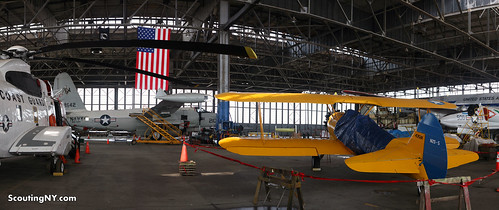
Hangar B was built in 1941 by the US Navy and used primarily for seaplanes. I have to admit, walking around and seeing everything from prop planes…
…to a World War II “Catalina”…
…to an old army ambulance…
…I suddenly had a very strong feeling that an Indiana Jones-style adventure scene was on the verge of breaking out around me.

The aircraft restoration efforts are the work of the Historic Aircraft Restoration Project, or HARP, created and staffed entirely by volunteers.
Many of the volunteers are retired aviation mechanics, a few in their 80’s; others are amateurs, willing to get a little greasy in exchange for learning about airplane restoration.
Every Tuesday, Thursday, and Saturday, HARP members gather to breathe a little more life into these aging beauties.
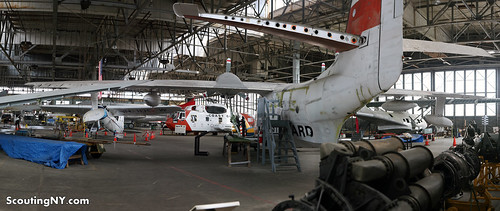
You could pretty much stumble onto any sort of aircraft in Hangar B, going as far back as this Wright Brothers model (a replica).
Though this one has never taken to the skies, it’s pretty cool to see how the Wrights’ revolutionary work with bike parts…
…would eventually lead to something like the Boeing C-97 Stratofreighter:
The Stratofreighter (I really wish the “strato” prefix would return to our product lexicon) was a long range heavy military cargo aircraft based on the B-29 bomber, and could carry up to 35,000 pounds.
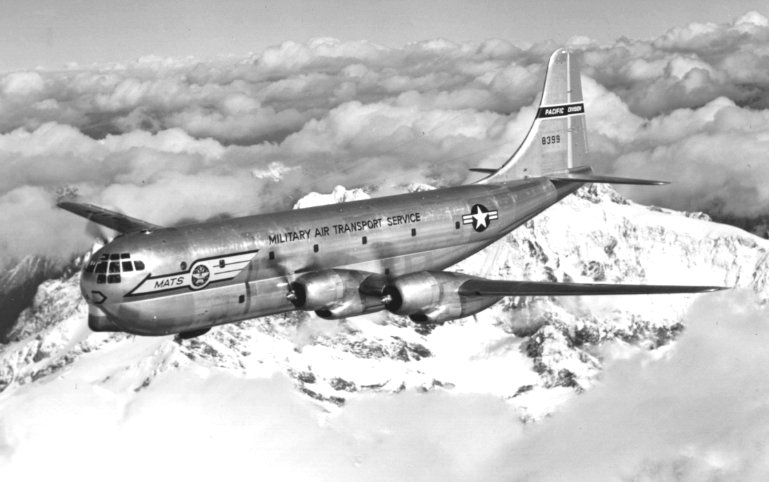
One of the defining features is its enlarged “double bubble” fuselage, which gives it an awesomely powerful look:
The Stratofreighter was the first mass-produced aircraft to feature a pressurized cabin, which would soon become the standard.
HARP works hard to meet the Smithsonian’s standard of aircraft restoration, namely: “If it doesn’t fly, it’s not an airplane.” Below is a fully restored Grumman JRF-5 “Goose” flying boat, which, back in the 1930’s, would have been used to transport wealthy Gold Coast clientele to Wall Street, literally landing in the river.
Later, “Gooses” were used by the Coast Guard and NYC Police Department, hence the paint job pictured above.
Another fascinating plane in great shape: the Lockheed SP2 H “Neptune” Anti-Submarine Patrol Bomber.
First flown at the end of World War II, the Neptune was designed with an observation fuselage, in which a bombardier would literally sit and stare at the water in hopes of spotting a sub.
One of the pleasures of exploring Hangar B is finding these planes exposed in ways you normally don’t get to see. Very cool to see the Neptune’s three engine coverings opened…
…to reveal its fascinating inner workings inside (I’m no expert, but I believe that’s a Wright R-3350 Cyclone Radial).
Mounted beside it, a Westinghouse Turbojet engine.
Curious how these enormous engines are moved around the hangar? Simple! You apparently attach the front bit into one of these dollies and push it around.
I imagine this is useful, as Hangar B is one of those fun places where spare aircraft engines are just sort of lying about everywhere.
The Neptune features an external bomb load…
…as well as a bomb bay. At one point, the Neptune was considered for use as a nuclear bomber, but this was eventually discarded, as the Neptune was unable to land on aircraft carriers.
Some of the planes in Hangar B are in pristine condition, like this Lockheed Vega “Winnie Mae” replica, finished just two weeks ago after six years of work. It was given a color scheme based on the plane famed aviator Wiley Post used to fly around the world twice in.
Others…er, have a little further to go…
This one was a recent donation from the Aviation High School in Queens. How do you transport a plane through New York City streets? Start by removing the wings…
Inside the fuselage…
…and into the engine:
HARP is currently vying for grant money from the Partners in Preservation program, which it hopes to use for important restoration work on its Douglas C-47 “Skytrain” Transport.
Considered to be one of the greatest aircraft ever built, the Skytrain was used extensively by the allies during World War II and flew in every theater of war up until 1975.
This particular model’s history is evident simply by looking at its rear emblem…
…where an outer layer of paint has been removed to reveal its World War II color scheme beneath.
I have absolutely no clue how any of this works, but I find something about the symmetry of the technology absolutely beautiful (again, I’m no expert, but I think that’s a Pratt & Whitney R-1830 Radial):
Specifically, the grant money from Partners in Preservation would go toward “removing corrosion, metalwork, re-skin degraded flight surfaces and prepare for historic paint scheme” authentic to World War II. Nice!
The Skytrain was based on the revolutionary DC-3 aircraft, which upped the number of passenger seats from the standard 12 to 22, making airline travel profitable for the first time in history.
Walking through Hangar B, I was particularly amazed by the longevity of some of the airplanes. Pictured below is a Grumman HU-16 “Albatross” Flying Boat, which first flew in October 1947 and was in use until March 1983. This very model holds the distinction of being the last fixed-wing amphibious aircraft flown by the US military.
The last aviation record set at Floyd Bennett Field was the first ever transatlantic helicopter crossing, using a Sikorsky HH 3-E “Pelican” Search & Rescue Helecopter (the model below is a 3-F).
Two copters made the trip to Paris, which required 30 hours 46 minutes of flight time and nine mid-air refuelings.
The Pelican’s loading ramp:
Finally, I wanted to mention the Douglas A-4 “Skyhawk” fighter jet.
First flown in 1954, here’s a picture of the Skyhawk in flight…
…though you probably know it better as the enemy planes used in Top Gun:
Historical sidenote: due to international treaty, all evil pilots are required by law to wear helmets with visors that cast weird reflections and obscure their faces.
What exactly is this strange pole extending from the front of the Skyhawk? That would be for mid-air refuelings:
Like most aircraft, the Skyhawk is covered in various warnings I always assume must be insanely obvious to people who work on planes. Like, I have to figure that if you’re close enough to the Skyhawk that its jet intake might be a problem, you probably know to stay clear…
Likewise, if you’re in a position to actually remove a plane’s nose, don’t you think you’d remember to disconnect the electrical wiring first?
A quick glimpse at the various weapons-related controls inside:
Part of the fun of visiting the HARP project is simply to see the old hangar. Built in 1941, Hangar B was intended to be torn down, a plan that was thankfully ignored.
There’s a lot of great ancient rusting machinery…
…areas with that classic “abandoned” patina…
…and always overhead, a really impressive latticework of steel holding up the old wooden frame:
HARP is open to the public on Tuesdays, Thursdays, and Saturdays from 9a to 4p, and I definitely recommend making the trip. In fact, now that the weather is nicer, why not take a bike ride out to Floyd Bennett Field? I always use the “close your eyes and try to head south-east” method, checking my map as few times as possible. The best way of finding something new is getting lost.
-SCOUT





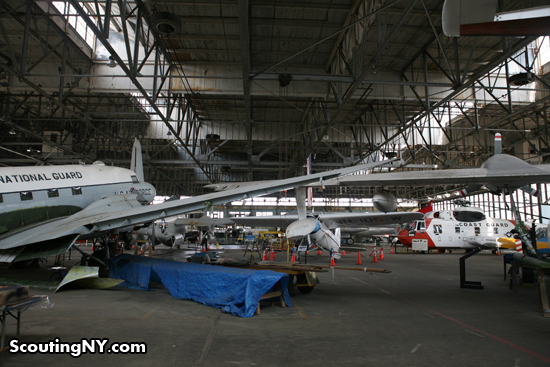

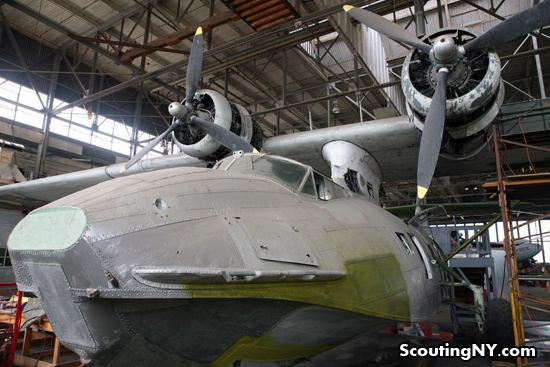

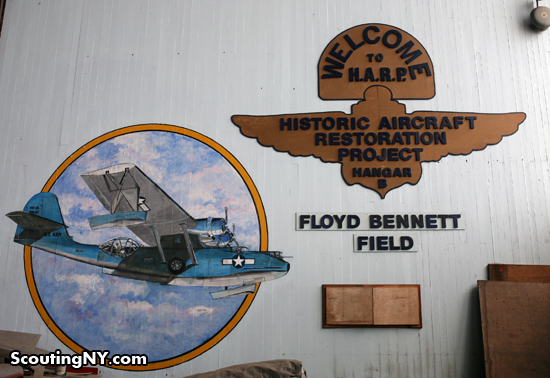
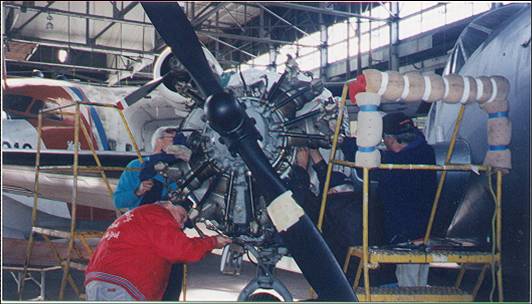
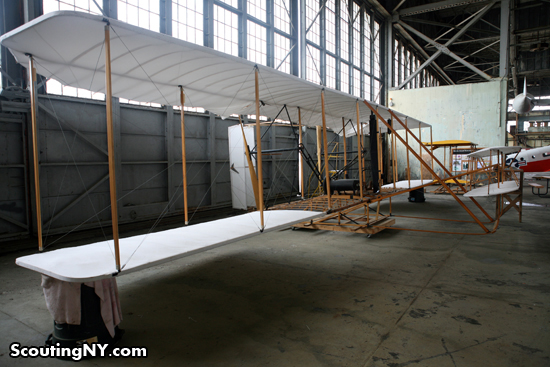
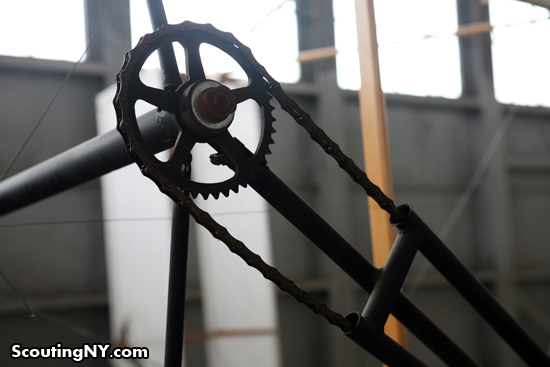
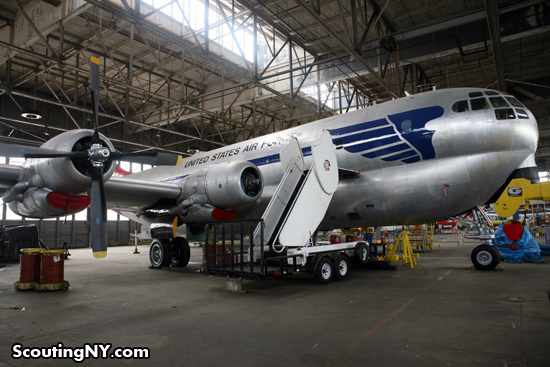
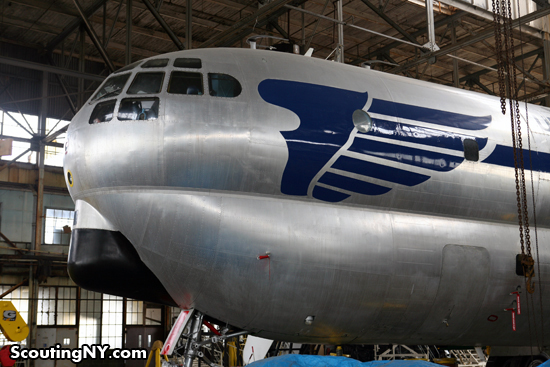
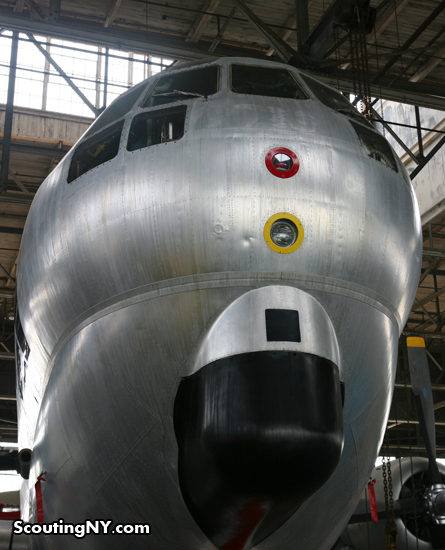
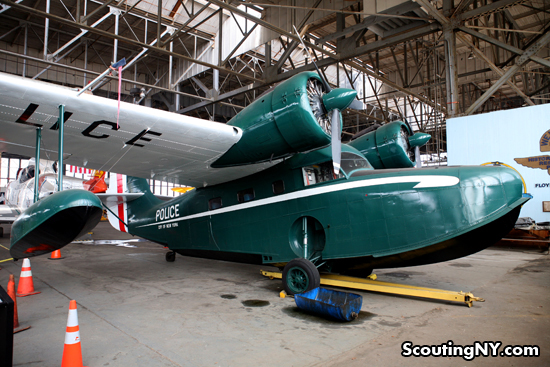
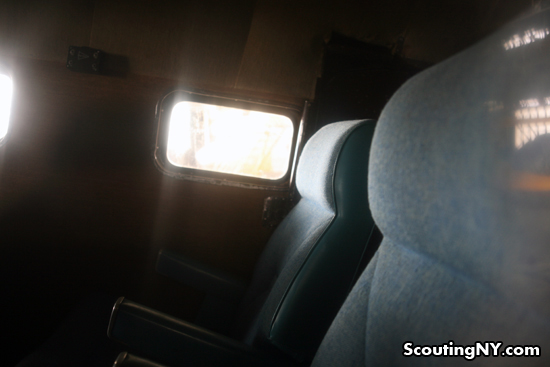

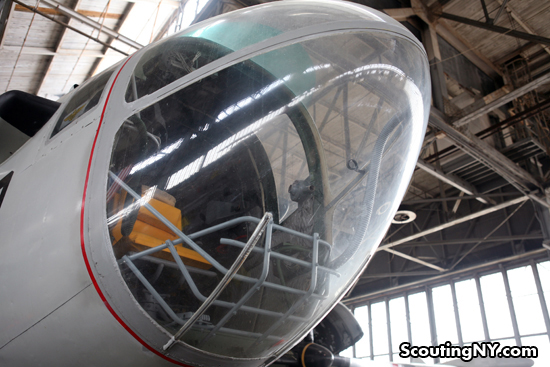
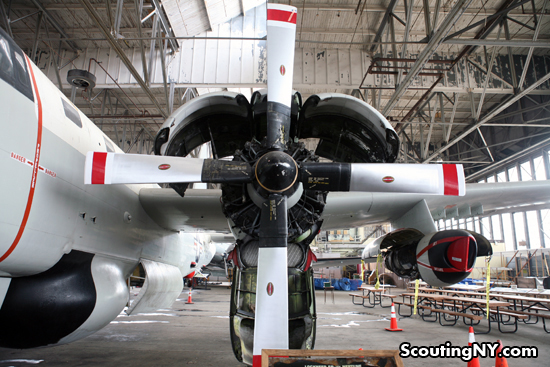




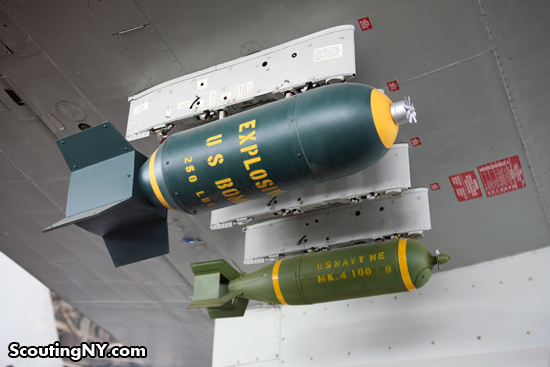

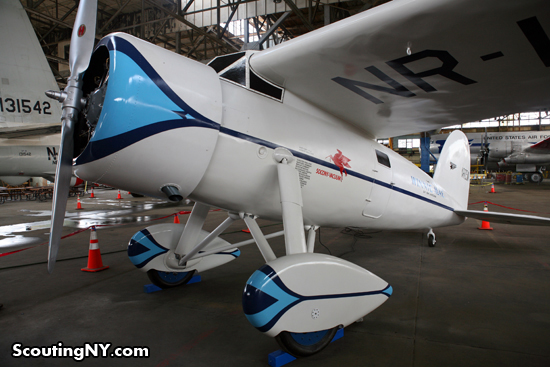
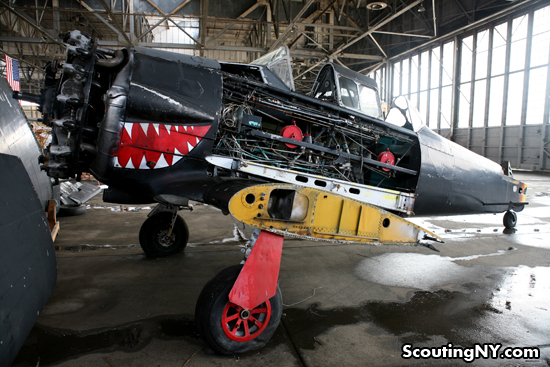
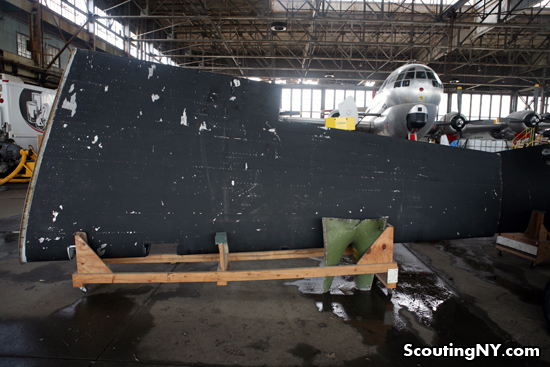
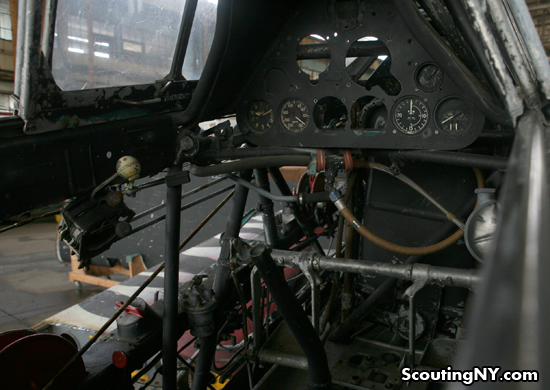
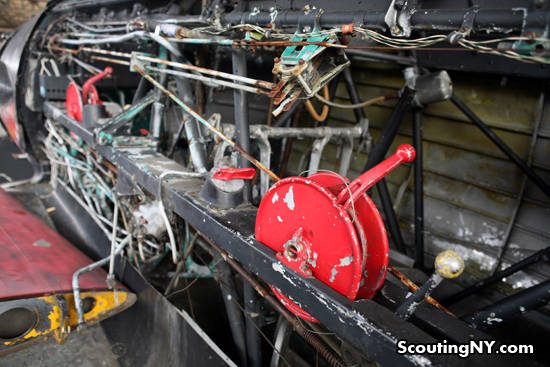
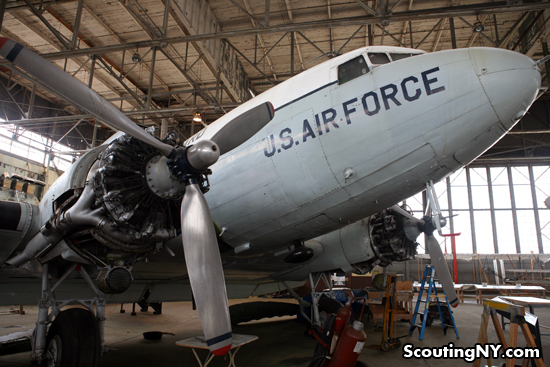
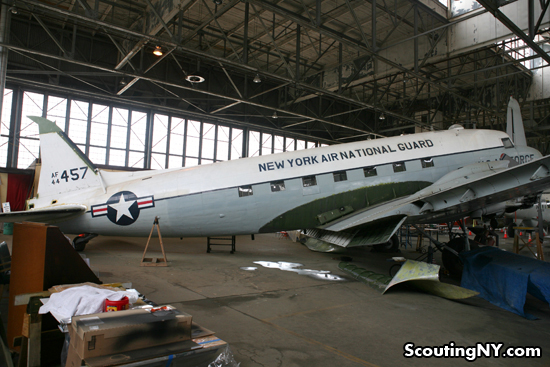

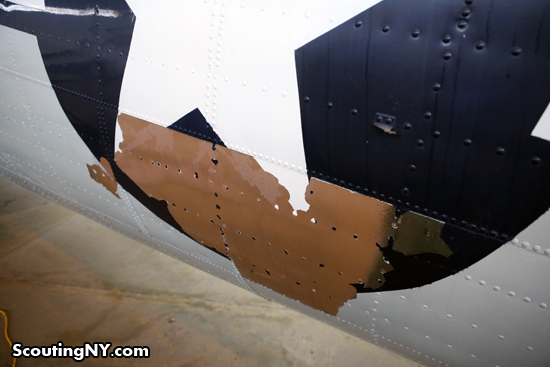
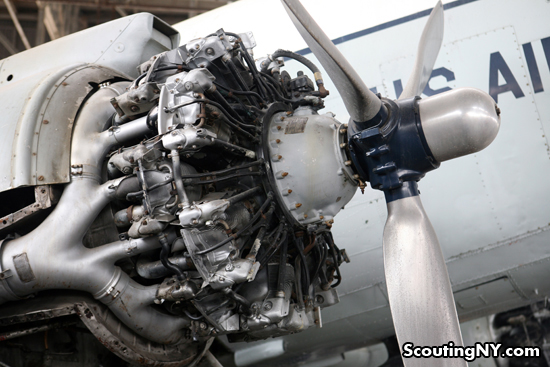

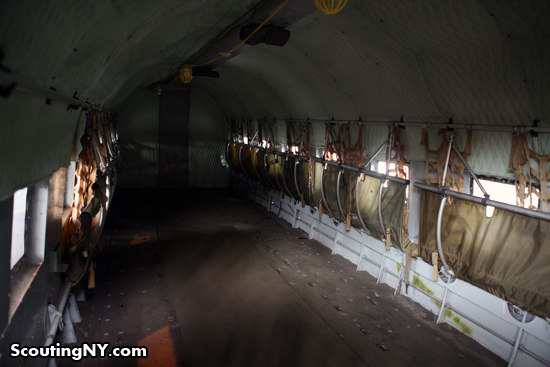
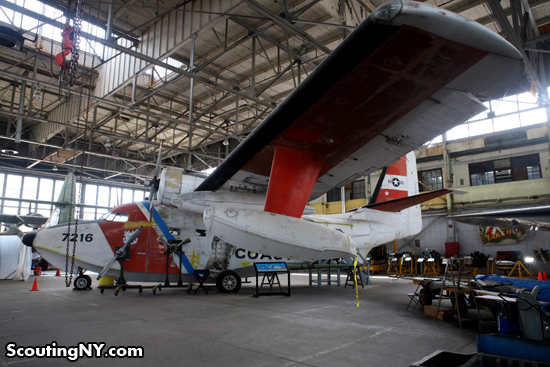




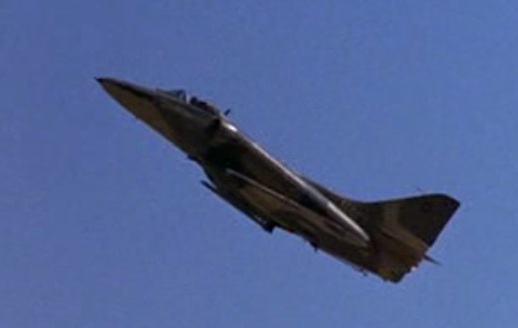
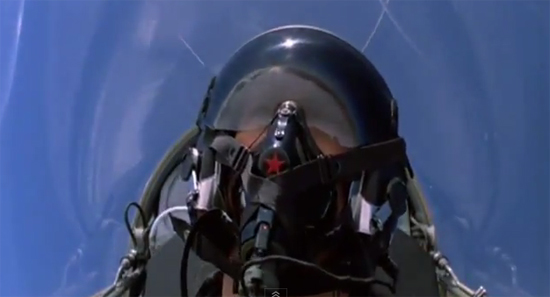

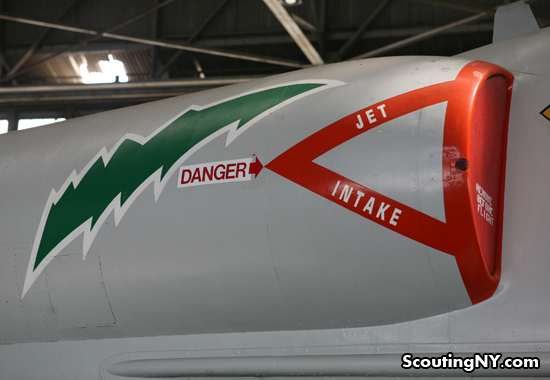
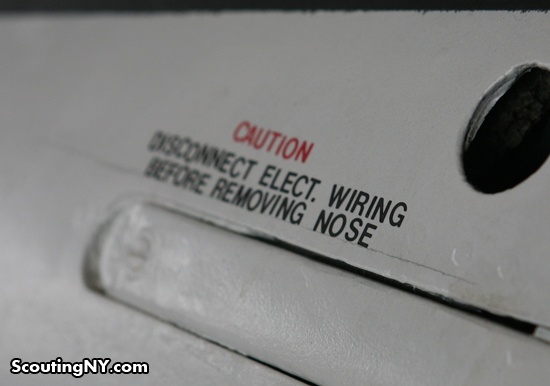
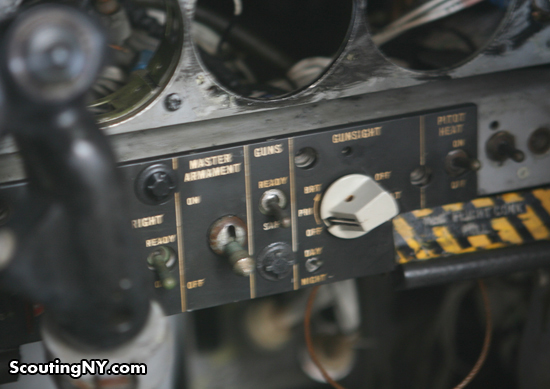
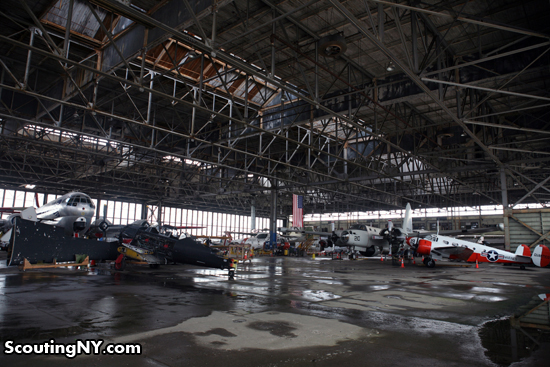
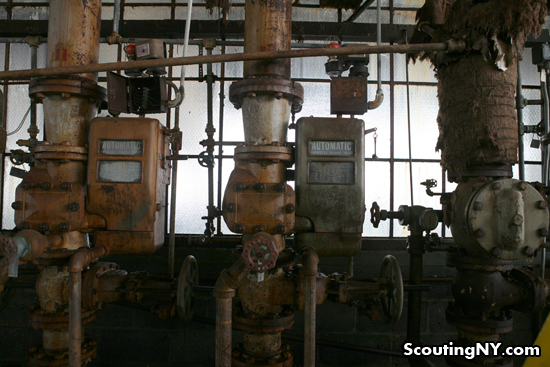

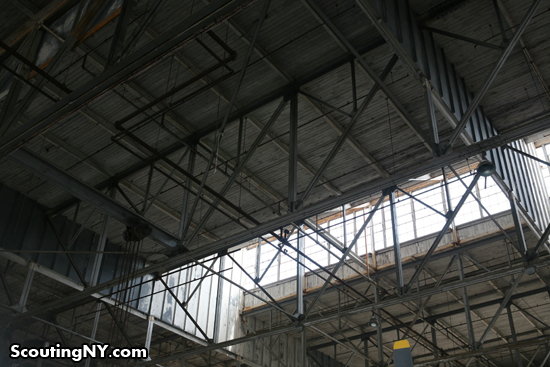
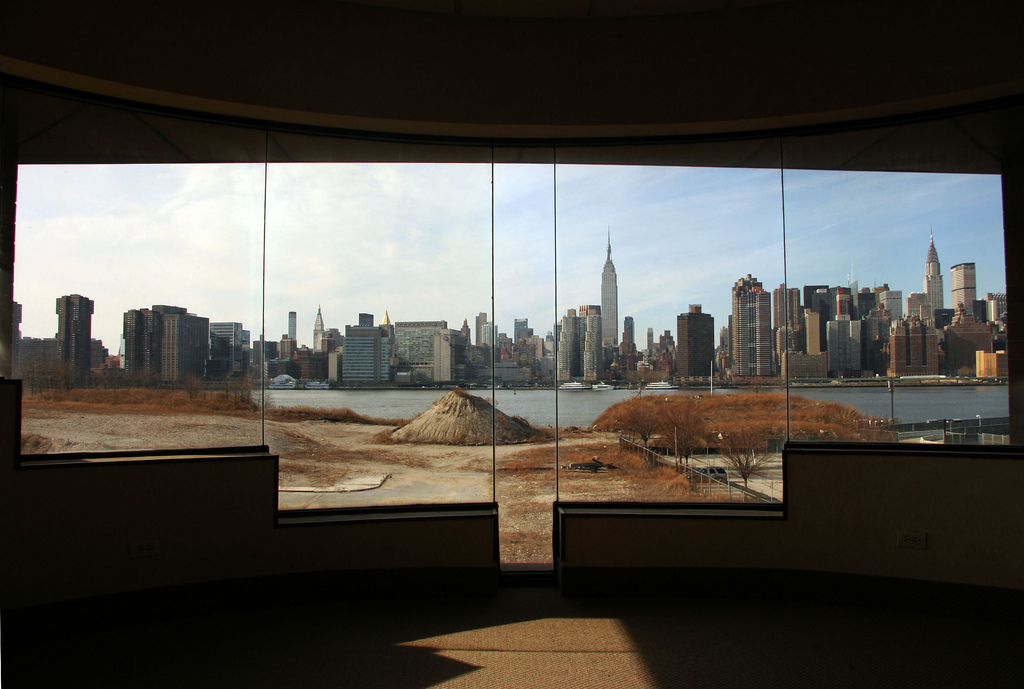
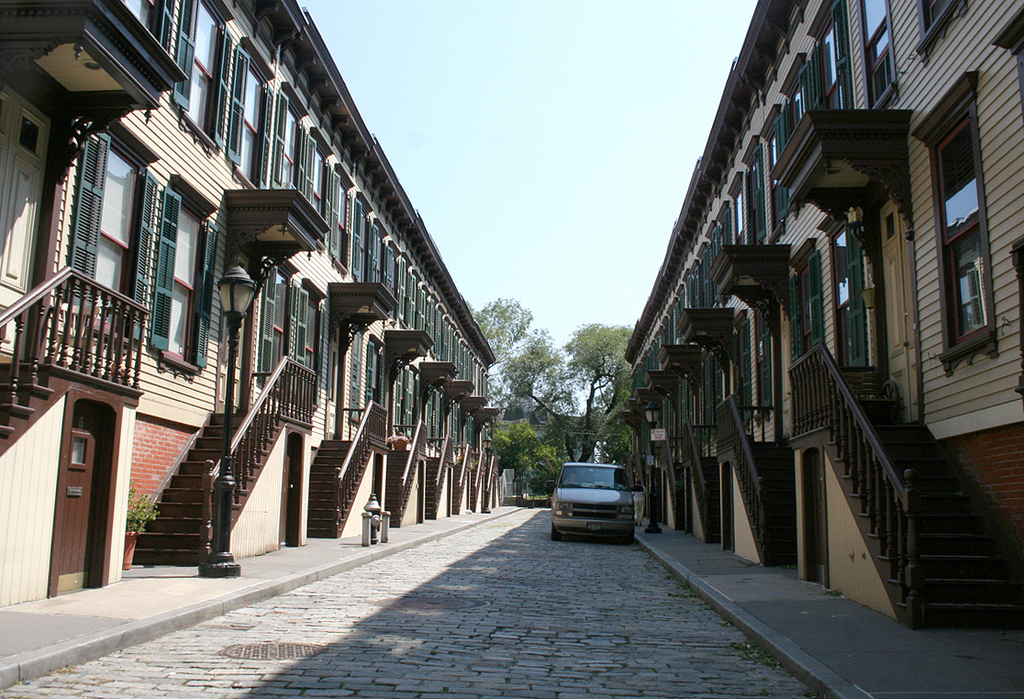

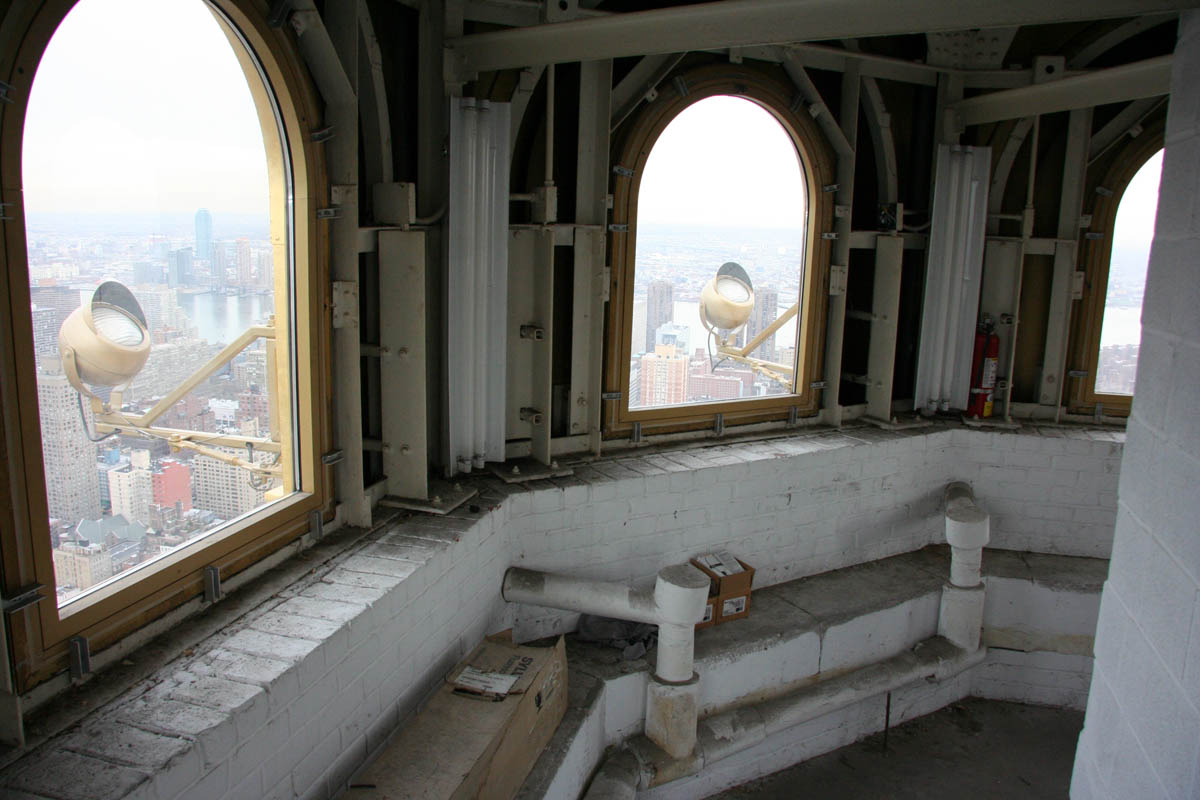


I grew up in Rockaway, just across the Jamaica Bay where Floyd Bennett is situated. In the fifties, the old prop planes would fly over our
school every day. It is still embedded in my memory. We used to bike ride over to FB but
it was off limits to enter. Great job Scout and I would also recommend traveling a mile more over the Marine Parkway Bridge to the Gateway National Park, another “gem!”
bmack
Thank You Scout for your “Scout” at Hangar B. I agree with you, the historic aircraft are a great find. Thanks for such a thorough photo essay. The National Park Service volunteers at HARP are the best, and amaze me everyday. Great chance now to fund the restoration of the park’s iconic World War II transport, just vote. Vote Gateway C47 Skytrain everyday, to support preservation at partnersinpreservation.com. Last weekend to vote – last day May 20th – make a difference.
I think the Top Gun enemy fighter is a Northrop F-5 or its training variant, the Northrop T-38, not a Skyhawk.
Oops, wrong picture. It was the “enemy” aircraft used while training at Top Gun, not the ones they encountered during real action.
“I have to figure that if you’re close enough to the Skyhawk that its jet intake might be a problem, you probably know to stay clear” – I used to go out with a Navy guy who’d been stationed on an aircraft carrier for a number of years. He said the number of times the flight deck crew (known affectionately as “deck apes”), who worked around the planes every day and were highly trained to do so, were sucked into intakes on a surprisingly regular basis.
Sorry, I realize that last sentence is sort of confusing, it was supposed to read “He said the number of times the flight deck crew (known affectionately as “deck apes”), who worked around the planes every day and were highly trained to do so, was fairly substantial, because they were sucked into intakes on a surprisingly regular basis.” Mea culpa!
Very neat. Thanks for sharing. Will have to take a ride down there with my kids some weekend.
I have had the pleaseure of visiting there a few times my daughter even performed there with a local Community Theater at one of their fundraising events. A great place to spend the afternoon with the kids !!!
I was there about 10 years ago and was so impressed with the dedication of these guys. They live for these machines and do amazing work. I think I recall a Vietnam-era “Huey” helicopter when I visited. I wondered then how people would even know to visit this place since it’s kind of out back and beyond.
Trivia about the Vega – Amelia Earhart broke two records, including the first crossing of the Atlantic by a woman, in a red Lockheed Vega before moving up to the larger Electra. Neat little plane.
There’s a huge military airplane museum at the naval training school in Pensacola, Fla. Very similar to this but I’d guess a bit bigger. Worth a visit if you’re an aviation buff and ever find yourself down there.
I just love that whole area, so getting to see your Hanger B pictures is a treat. Looking forward to getting down there again soon. Especially Ft. Tilden
I think “The best way of finding something new is getting lost” should be this blog’s tagline! Another great post. You’re the best.
You talk about the Boeing Stratofreighter, but neglect to point out that there was a passenger version. Stratocruiser, which had a downstairs cocktail lounge. PanAm and BOAC used this aircraft on their transAtlantic routes—they landed almost daily in Keflavík (Iceland) for refueling when I was a disc jockey there (1950s).
Great job scouting this one out. I would give my eyeteeth for a day there. Some neat old birds in there. C-47’s/DC-3’s are still out there working. I recently saw one that had been re-engined with turbo props. The Scooter (A-4) has long been one of my favorite aircraft. It was also called Heinemann’s Hot Rod after the designer.
Very interesting find. This is like the airport version of the Intrepid. Were there on staff guides like the museum?
Many of the planes that were restored used to sit outside at Floyd Bennett Field behind the control tower. Back when it was still a quiet abandoned base, before the sports complex and removal of the giant more modern hangar along Flatbush Ave.
I spent 9 years at NASNY – 2 reserve & 7 years active duty. When I left in Aug 1965, I was an AE1. I used to fly ASW crew (training) on the P2V-5f & the S2F & I worked mostly on the jet line, especially the A4d. That fueling boom was our access to the cockpit when we were young & strong. Up on the drop tank, across the wing & out on the boom. Best time of my life.
I worked on the c 97s stationed with the NY Air National Guard during the sixties. Great aircraft for its time.
In January,1956 I joined the Marine Corps reserve at Floyd Bennett Field while still in High School. I was 17 years old at the time, a tough kid from Brooklyn. It was a great thrill to see all the Military uniforms and military aircraft on the field during weekend drills so I figured if I became active duty I could take over the Marine Corps. In July I transferred to active duty and found myself in Parris Island ,SC as a recruit in Platoon 222. Still a 17 year old wise guy from Brooklyn looking for trouble. Parris Island and The four years on active duty completely changed me and my attitude for the better. . Life has never been the same since then. It all started at Floyd Bennett Field in Brooklyn,NY.
PS Several of my friends who stayed in Brooklyn ended up in trouble with the law.
Thanks for the great tour of the aircraft, etc.
In 1968, I volunteered and signed up at NAS Floyd Bennett,
prior to going onto Aviation Officer Candidate School and
Flight Training at NAS Pensacola.
Just FYI, the Navy had A-4’s based at Floyd Bennet in the 60’s when it was an active military base.
I was a member of the 114th Bomb Sq {L} at Floyd Bennett in 1948. This was an ANG organization.
We were activated in 1951 when the Korean War came into being. WE were flying the A-26
at that time period.
It was interesting to discover that Hanger B is still there after all these years. Hanger B was my duty station at Floyd Bennett during the years 1957 to late 1959. I was an Aerographer’s Mate and our office was co located with ops. It brings back many memories for me, I learned a lot while serving there and the ultimate result was a good job with the National Weather service. I am now retired and am living in the San Francisco area. Would love to visit the old place and may do so if we ever get back that way. Great to see that the old hanger liives on as a very interesting museum!
FWIW Hangar 4 has been closed for many months for roof repairs.
However HARP’s Facebook page says it will reopen in July 2016.